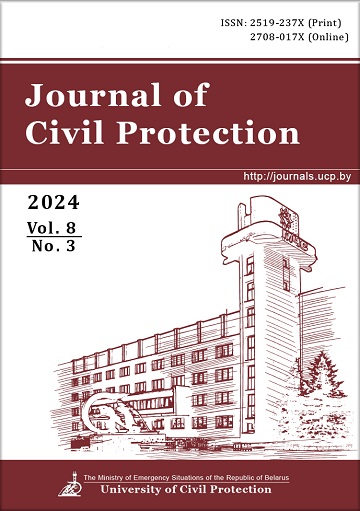Improvement of the system of ensuring radiation safety of the border service of the Republic of Belarus
DOI:
https://doi.org/10.33408/2519-237X.2024.8-3.301Keywords:
artificial intelligence, radiation safety, cross-border movement of nuclear and radioactive materials, software and hardware complex, radiation and dosimetric monitoring, state border, radiological emergencyAbstract
Purpose. Development and justification of the most promising areas for integrating artificial intelligence into the radiation safety system of border service agencies in order to increase its efficiency.
Methods. Analysis of the capabilities of artificial intelligence and extrapolation of the scope of its application into the radiation safety system of border services, modeling of the technical component of the system taking into account the integration of artificial intelligence.
Findings. The main factors determining the relevance of the use of artificial intelligence have been established, and the most promising directions for its application in the system for ensuring radiation safety of border service agencies have been proposed. An analysis of the technical means of radiation and dosimetric monitoring was carried out, which made it possible to develop the basic requirements for the elements of the system, taking into account the integration of artificial intelligence, including the basic design of data transmission and the possibility of introducing means of remote radiation monitoring and reconnaissance using a promising software and hardware complex for radiation monitoring and unmanned aerial vehicles. An elemental base of a software and hardware complex for radiation monitoring has been proposed, providing the possibility of introducing technologies for analyzing, assessing and forecasting the radiation situation within a section of the state border in the event of a radiological emergency, as well as choosing the optimal route for conducting aerial and ground radiation reconnaissance, taking into account the ability of artificial intelligence to remotely control unmanned aerial vehicle.
Application field of research. Ensuring radiation safety of border service of the Republic of Belarus.
References
Andresz S., Zéphir A., Bez J., Karst M., Danieli J. Artificial intelligence and radiation protection. A game changer or an update? Radioprotection, 2022. Vol. 57, No. 2. Pp. 157–164. DOI: https://doi.org/10.1051/radiopro/2022004.
Kenigsberg Ya.E., Kryuk Yu.E. Obluchenie shchitovidnoy zhelezy zhiteley Belarusi vsledstvie chernobyl'skoy avarii: dozy i effekty [Thyroid gland exposure of Belarusian residents due to the Chernobyl accident: doses and effects]: monograph. Gomel: Institute of Radiology, 2004. 121 p. (rus)
Barabanova A.V., Osanov D.P. Zavisimost' tyazhesti luchevykh porazheniy kozhi ot glubinnogo raspredeleniya dozy beta-izlucheniya u postradavshikh pri avarii na Chernobyl'skoy AES [Relationship between the severity of radiation involvement of the skin and the in-depth distribution of the absorbed dose of beta-irradiation in subjects who suffered in the Chernobyl Power Plant accident]. Medical Radiology, 1993. Vol. 38, No. 2. Pp. 28–31. (rus). EDN: https://elibrary.ru/KSRLBH.
Bugay A.N., Vorob'ev D.V.Nekotorye aspekty otsenki vliyaniya prognoziruemoy radiatsionnoy obstanovki na vypolnenie zadach po okhrane gosudarstvennoy granitsy v mirnoe vremya [Some aspects of the evaluation of the predicted radiation situation influence on the state border protection tasks completion]. Vestnik instituta pogranichnoy sluzhby Respubliki Belarus', 2021. No. 2. Pp. 26–33. (rus). Url: https://ips.gpk.gov.by/nauchnaya-deyatelnost/nauchnye-izdaniya/vestnik/Vestnik%202%202021.pdf
Venttsel' E.S., Ovcharov L.A. Teoriya sluchaynykh protsessov i ee inzhenernye prilozheniya [Theory of random processes and its engineering applications]: tutorial. Moscow: KnoRus, 2014. 448 p. (rus)
Khomyakov N.N. Avtomatizirovannaya intellektual'naya sistema prinyatiya upravlencheskikh resheniy v khode likvidatsii posledstviy radiatsionnykh intsidentov na osnove fiziko-matematicheskogo modelirovaniya [The automated intellectual system of acceptance of administrative decisions during liquidation of consequences of radiating incidents on the basis of physical and mathematical modelling]. Civil Security Technology, 2010. Vol. 7, No. 4 (26). Pp. 60–67. (rus). EDN: https://elibrary.ru/NBRYFT.
Bugay A.N. Protivodeystvie nezakonnomu transgranichnomu oborotu opasnykh materialov i veshchestv kak faktor obespecheniya pogranichnoy bezopasnosti Respubliki Belarus' [Counteraction to illegal cross-border trafficking of hazardous materials and substances as a factor in ensuring border security of the Republic of Belarus]: monograph. Minsk: Institute of Border Service of the Republic of Belarus, 2014. 261 p. (rus)
Published
How to Cite
License
Copyright (c) 2024 Il'yuchik E.A., Bugay A.N.

This work is licensed under a Creative Commons Attribution-NonCommercial 4.0 International License.




















